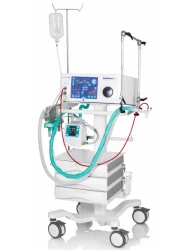TWINSTREAM®
ICU WITH P-BLV®
(PULSATILE BILEVEL VENTILATION)


The Austrian critical care ventilator
TwinStream® ICU was designed
with the explicit purpose of saving
critically respiratory-distressed patients.
In particular those patients with severe
lung diseases (e.g. ARDS) who can no
longer be supported with conventional
ventilation.
Its unique p-BLV® mode has become an
established value in many Intensive Care
Units in Austrian and German hospitals.
And when severe multi-trauma patients
are admitted the TwinStream® ICU often
proves to be an effective last resort.
Since the start of the pandemic the
TwinStream® ICU has become an
invaluable asset in the fight against
Covid-19. Prof. Dr. Thomas Uhlig, Clinic
director and head of the ICU at the
Lüdenscheid Clinic, Germany, explains:
Why is the TwinStream® ICU such an
important asset in the fight against
Covid-19?
“We ventilate all Covid-19 patients which
require intubation with the TwinStream®
ICU first, until we see a clear improvement
of the oxygenation, because p-BLV® is
much more efficient at recruiting lung
volumes than other ventilation methods.
Hypercapnia is another problem we are
faced with after non-invasive ventilation.
With p-BLV® we can kill two birds with one
stone. Its combination of high-frequency
ventilation (improved oxygenation) and
low-frequency ventilation (efficient CO2
elimination) makes it our most effective
ventilation method for this type of
patients.”
How long are Covid-19 patients usually
ventilated by the TwinStream® ICU?
“As soon as the PaO2/FiO2
ratio and
airway pressures are again within a
tolerable range, a conventional ventilator
can take over. But if there is an acute
deterioration, we ventilate with the
TwinStream® ICU again. Our average
patient is ventilated for around 14 days,
of which on average around 5-7 days
with the TwinStream® ICU.”
How old are the Covid-19 patients which
you have ventilated so far?
“Since April we have ventilated Covid-19
patients between the ages of 20 and 85.”










